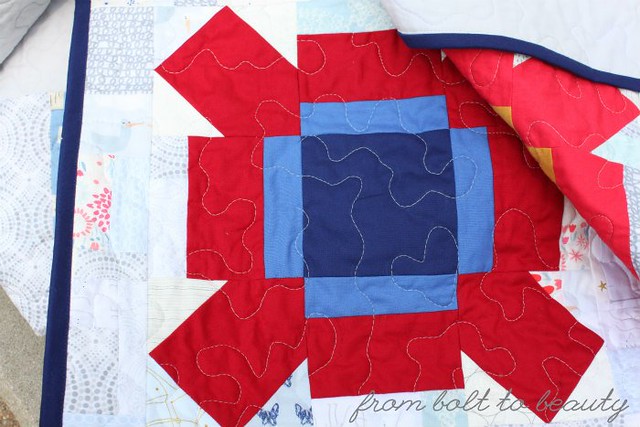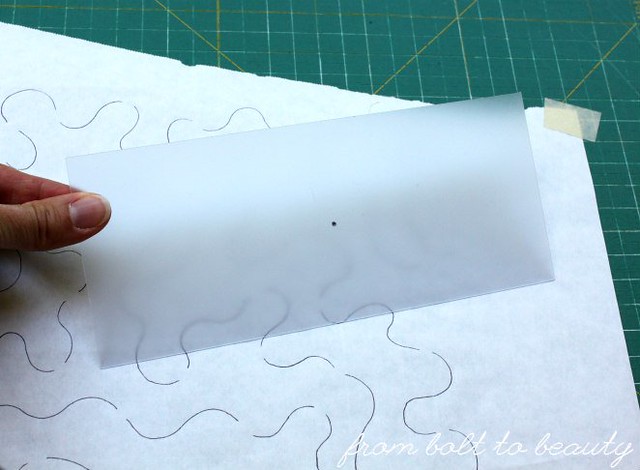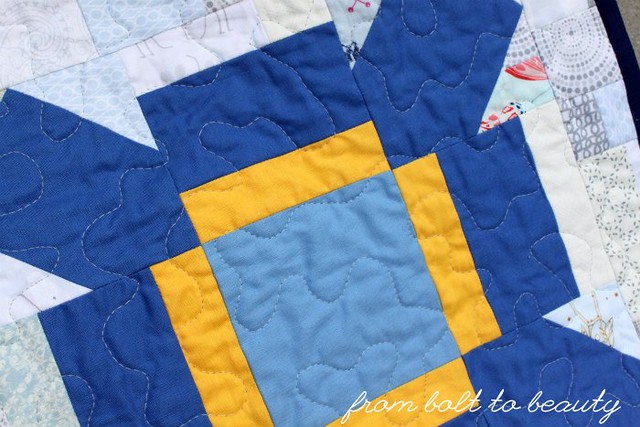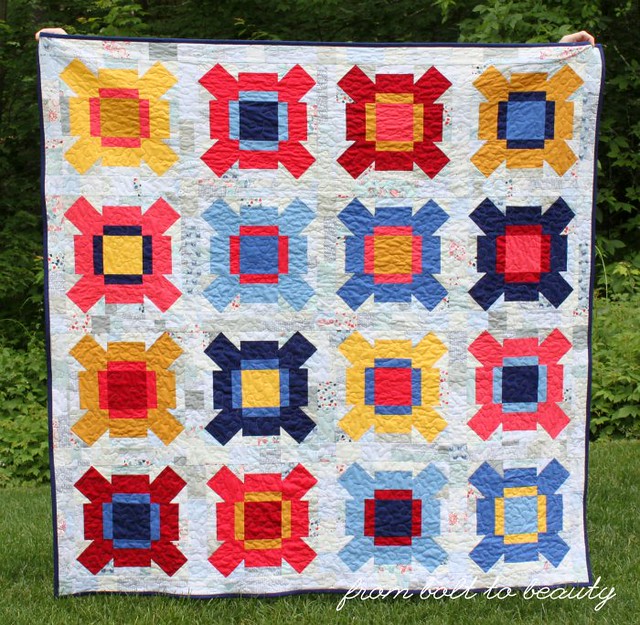 |
| Look! I can free-motion quilt! |
I like straight-line quilting, and the motifs I can create with a straight stitch and walking foot usually serve me well. Every 12 to 18 months, however, I decide that I need to face my fear of free-motion quilting (FMQ). After all, FMQ has its perks. I like the idea of quilting without doing much, if any, marking (and I almost always mark when I straight-line quilt). Plus, some quilt designs require the softening that only FMQ’s swirls and loops can provide.
These forays into FMQ follow the same pattern: I get out my darning foot and plate, watch some videos online, give FMQ a shot, and throw in the towel when I’m not great at it from the get-go. In the end, all I’ve wasted is some thread and practice quilt sandwiches.
My most recent attempt was different, though. I started by hanging out with a friend—someone I consider an expert in FMQ—to pick her brain and practice a bit. And it was hard. I had to focus on so much! So we talked about different ways I could practice, improving my approach and building my muscle memory.
I ended up making some compromises. First I invested in some inexpensive stencils, figuring they’d help me work on maintaining a consistent stitch length and making pretty, round corners without having to think about where I was headed next with my quilting. Then I practiced with a stipple stencil. I’m not crazy about the look of stippling, but it’s forgiving—a good FMQ design to start with. I traced my stipple stencil on some freezer paper, taped it to my cutting board, and using a simple rectangle of leftover template plastic marked with a black dot, pretended I was moving a quilt under the needle of my machine. Then I moved to quilting practice sandwiches. Finally, I moved on to an actual quilt.
 |
| This was my simple solution to working on my muscle memory. |
In the end, the experience went better than I thought it would. I offset each row of stippling to camouflage the fact that I used a stencil, and that worked well. Whenever things got too wonky, I stopped quilting, tied off the thread at a good spot, and buried the ends. It wasn’t efficient, but I wanted the final quilt to be good enough to gift. Of course, with the stencil, I had to mark every line of quilting with a water-soluble marker. Oh well—I did what I had to do to make FMQ work for me!
 |
| This was the ideal project to work on my FMQ. A lot of imperfections were camouflaged by the gray thread and improv background. |
 |
| Here is the finished quilt! Read more details here. |
I haven’t done any FMQ since that project, so I suspect my next attempt will require a lot of practice again. That’s fine with me—I have the confidence to make it happen a second time.
Are you into FMQ? What words of wisdom can you share with a newbie like me?
Linking up to Let’s Bee Social ...

I have no words of wisdom other than keep on practicing. I'm one of the folks who don't practice enough to be super comfortable...but I keep trying. I'm working on trying a little more often than I used to. I also made myself a lap sized quilt sandwhich to practice on with one of my videos because I find if I only practice on small sandwhiches, so the transition from sandwhich t quilt is better.
ReplyDeleteSo... a stipple was crazy hard for me to learn to FMQ. Because I love straight lines so much (and I know you do, too!!), I actually found a boxy meander or boxy stipple to be much, much easier to learn as my first FMQing motif. I actually took a class and tried a lot of motifs and realized that (shocking) I was best at all the more strongly linear designs. So I started with that. Because there *is* a long to remember to coordinate, so once I got comfortable I could branch out and start trying softer, rounder shapes. Anyway, that's the path that worked for me. I think it's great you used a stencil and it looks great to me! All my quilting has imperfections. :)
ReplyDeleteJust posting a comment so I can be notified of others' comments. Hopefully, Blogger will fix this comment glitch soon!
ReplyDeleteI've read that doodling on paper is a good method to practice FMQ designs. I often work it out with a finger running over the flimsy surface before I start just to give myself more of a mental image, and always try out a new design on a throwaway scrap, even if it's not an actual sandwich. Practice and more practice, and remember that you can call an oopsie a Mistake or a Design Decision!
ReplyDeletePractice!!! Also, doodling in boring meetings can help too. ;) Your FMQ looks great! Stop doubting yourself and just quilt. :D
ReplyDeleteI find that quilting (on my domestic machine) in whatever direction helps me see where I have been (rather than where I am going) works best for me when I do FMQ. This means quilting from the bottom of the quilt up, which is opposite of what I do when I use a walking foot. Also, I'm more comfortable quilting away from the harp, bunching up the quilt first and then having it feed out so that it gets easier and easier. I do work in the other direction, too, but it's just easier to quilt my way out. I also sort of imagine that I am making puzzle pieces, and when I started, quilting smaller (and quilting slowly) was easier than quilting widely spaced lines to get smooth curves. I hope that all makes sense. Also, thanks to this great quilting community I have a fix for Blogger for you. I wrote you a separate email about it in case this comment doesn't get to you easily. I hope it works for you!
ReplyDeleteIt's helpful for me to relax as I begin to FMQ. Practice with music on, pretend it's just for fun and don't tense your arms or hands. Scribble and just play at first to get the feel of it. This might sound odd but what helped me with my stipple was picturing a puzzle piece in my head, then practicing to get my hands to duplicate what I saw. I still use that visual to get nicely rounded stipple curves. Good luck finding the way that works best for you!
ReplyDeleteI am getting better, but I doubt it will ever be my passion. I can now happily do simple designs on baby quilts. I refuse to torture myself with anything bigger, and I am a bit out of practice.
ReplyDeleteIt is funny that you like straight lines – I still have not managed to balance the drag between the layers, even with the walking foot on and foot pressure adjusted. The only thing I dislike more than FMQ is straight line quilting!
My tip for FMQ: one glass of wine to ease the tension in arms, etc. and allow myself to let the mistakes go!
Kudos for continuing to work on FMQ. It looks great. I think practice is the key. And I agree with Yvonne -- maybe try the boxy stipple. I don't FMQ very well on my domestic, but I can do it well on my Pfaff mounted on a frame (like a longarm).
ReplyDeleteI think the key is to know that small sections may not look as good as you want, but the finished, bigger picture is a different story - FMQ is very forgiving and the odd long or pointy stitch is hard to find when looking at a full quilt.
ReplyDeleteSo great that you didn't let your fear stop you. I agree with Yvonne - stippling is actually one of the harder motifs to FMQ. I don't know why people suggest doing that one first. Loops and boxy loops are much easier in my opinion.
ReplyDeleteYour quilt is so colorful and fun. I actually have problems with loops because I often get eyelashes on the back. They say it takes practice and that must be true, but I'm still not there yet. Enjoy your quilt as it is lovely. A finished quilt is everything!!
ReplyDelete